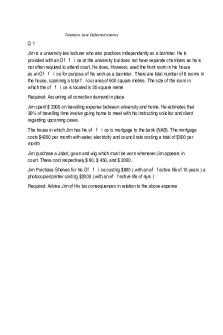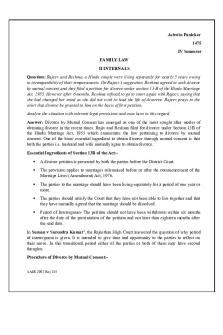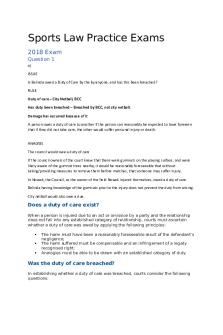Rules of Law - Important for Exams. PDF

| Title | Rules of Law - Important for Exams. |
|---|---|
| Course | Criminal Law |
| Institution | Barry University |
| Pages | 4 |
| File Size | 89.9 KB |
| File Type | |
| Total Downloads | 79 |
| Total Views | 159 |
Summary
Important for Exams....
Description
Merger Doctrine Merger Doctrine: In criminal law, if a defendant commits a single act that simultaneously fulfills the definition of two separate offenses, merger will occur. This means that the lesser of the two offences will drop out, and the defendant will only be charged with the greater offense. This prevents double jeopardy problems from arising. Rule of lenity, also called the rule of strict construction, is a principle of criminal statutory interpretation that requires a court to apply any unclear or ambiguous law in the manner that is most favorable to the defendant. Felony Murder The felony murder rule is a rule that allows a defendant to be charged with first-degree murder for a killing that occurs during a dangerous felony, even if the defendant is not the killer. The felony murder rule applies only to those crimes that are considered “inherently dangerous,” Inherently Dangerous Crimes Inherently dangerous crimes may vary by state, but typically include burglary, robbery, rape, arson and kidnapping. However, under the merger doctrine, if the elements of the underlying felony are a part of the elements of murder, the felony murder rule cannot be applied. For example, a defendant who participated in an assault in which someone was killed could not be charged with felony murder because the elements of assault are also incorporated in the elements of a murder. Thus, the assault “merges” into the murder and is not a distinct crime that can constitute the underlying felony. Burglary 1. 2. 3. 4. 5.
Breaking and entering The dwelling house Of another At nighttime With the intent to commit a felony therein – Elements must concur at the moment of entry
Larceny [1] Wrongful Taking. … [2] Carrying Away. … [3] Personal Property. … [4] Property of Another Person. … [5] Taken Without Consent. … [6] With Intent to Steal (Intent can be developed later on.) Embezzlement 1. Person (e.g., trustee) has lawful possession (retail clerks generally only have custody (limited authority; not as broad as possession and thus are likely to be guilty only of larceny, not embezzlement–) 2. Of property of another 3. Fraudulently converts it (e.g., to personal use or a use inconsistent with the appropriate purpose)
4. Breach of trust Assault
a.
The defendant acts. b. The defendant intends to cause the victim to apprehend imminent harmful contact from the defendant. c. The defendant's action causes the victim to reasonably apprehend such a contact.
Robbery 1. Elements of larceny (a lesser included offense) 2. from a person (or in victim’s presence) 3. Use of force or fear Continuing trespass doctrine a wrongful act involving a course of action which is a direct invasion of the rights of another. o a trespass in the taking of goods, although without intent to appropriate them, followed by an appropriation, the original trespass being deemed to continue to the time of the appropriation, so that the subsequent appropriation is larceny.
o
Larceny by trick is distinguishable in that a defendant who commits larceny by trick obtains only possession of the personal property of another, not title of that property. Also, the defendant who commits larceny by trick obtains possession of the property by intentionally making a false statement to the victim. Embezzlement is the act of withholding assets for the purpose of conversion (theft) of such assets, by one or more persons to whom the assets were entrusted, either to be held or to be used for specific purposes. False Pretenses Under common law, a defendant commits the crime of false pretenses when by making an intentional statement with intent to defraud the victim he obtains title to the personal property of the victim. For a defendant to be convicted of this crime, the intentional false statement he makes to the victim must reference a past or present fact or event, a false statement regarding the future or some sort of future promise would not suffice to satisfy that element of the crime. False pretenses differ from larceny in that title, and not just possession of the victim's personal property is obtained by the defendant. Murder
under the common law are: (1) the unlawful killing of; (2) a living person; (3) with malice aforethought; (4) in the absence of provocation legally sufficient to mitigate murder to manslaughter, and; (5) without justification or excuse (i.e., unlawfully). Year-and-a-day rule Provides that a defendant will not be liable for murder if the defendant’s conduct results in a death that occurs more than one year and one day after the defendant’s actus reus. Some jurisdictions have altered this rule by statute. Felony-murder rule is a form of strict liability for murder. Generally, under the felony-murder rule, if a defendant causes another person's death in the course of committing or attempting to commit an inherently dangerous felony, the defendant is guilty of murder.
First-degree murder
a. willfulness, deliberate and pre-meditation. Willfulness refers to a person’s intent. The person had the intent to end a human life. Deliberation and pre-meditation refer to having enough time to plan the act and second guess the act; or a. Felony murder as specified by statue; or b. Killing by poison or lying in wait.
Second-degree murder
a. impulsively, and without premeditation, but with an intent and understanding of his actions. (heat of passion killing); or b. Intentionally (that is, purposely or knowingly) causing serious bodily injury but where death, though never intended, results; or c. Felony murder (if not raised to first degree by statue); or d. Depraved heart (or abandoned or malignant heart) murder (a special kind of extremely reckless kiling that exhibited indifference to the value of human life).
Voluntary Manslaughter A killing that would otherwise be murder but that is mitigated to manslaughter because it was done upon being reasonably provoked into a sudden heat of passion without cooling off where a reasonable person would not have cooled off. its elements therefore, are: a. Mental state that would ordinarily qualify as murder (for example, a purposeful killing); b. When the defendant has been provoked by the victim into the heat of passion; c. A reasonable person would have been provoked; d. The defendant has not cooled off by the time of the killing; and
e. A reasonable person would not have cooled off. Involuntary manslaughter a. In some jurisdictions, a reckless killing (provided that it is not of the special type of recklessness that elevates the crime to depraved-heart murder); in other jurisdictions, a criminally negligent killing; and, in other jurisdictions, a killing done with ordinary tort negligence; or b. Misdemeanor-manslaughter c. Imperfect Self-Defense. (There is a disagreement as to whether imperfect selfdefense belongs in the voluntary or involuntary category). Rape Common law definition: “carnal knowledge of a woman forcibly and against her will.”...
Similar Free PDFs

Quick Reference Rules of Law
- 4 Pages

Taxation Law Deferred exams
- 7 Pages

Admin LAW - Important notes
- 44 Pages

Company LAW Exams Answers
- 6 Pages

Family Law Internal Exams
- 4 Pages

Sports Law Practice Exams
- 2 Pages

Family Law past exams answers
- 22 Pages
Popular Institutions
- Tinajero National High School - Annex
- Politeknik Caltex Riau
- Yokohama City University
- SGT University
- University of Al-Qadisiyah
- Divine Word College of Vigan
- Techniek College Rotterdam
- Universidade de Santiago
- Universiti Teknologi MARA Cawangan Johor Kampus Pasir Gudang
- Poltekkes Kemenkes Yogyakarta
- Baguio City National High School
- Colegio san marcos
- preparatoria uno
- Centro de Bachillerato Tecnológico Industrial y de Servicios No. 107
- Dalian Maritime University
- Quang Trung Secondary School
- Colegio Tecnológico en Informática
- Corporación Regional de Educación Superior
- Grupo CEDVA
- Dar Al Uloom University
- Centro de Estudios Preuniversitarios de la Universidad Nacional de Ingeniería
- 上智大学
- Aakash International School, Nuna Majara
- San Felipe Neri Catholic School
- Kang Chiao International School - New Taipei City
- Misamis Occidental National High School
- Institución Educativa Escuela Normal Juan Ladrilleros
- Kolehiyo ng Pantukan
- Batanes State College
- Instituto Continental
- Sekolah Menengah Kejuruan Kesehatan Kaltara (Tarakan)
- Colegio de La Inmaculada Concepcion - Cebu








